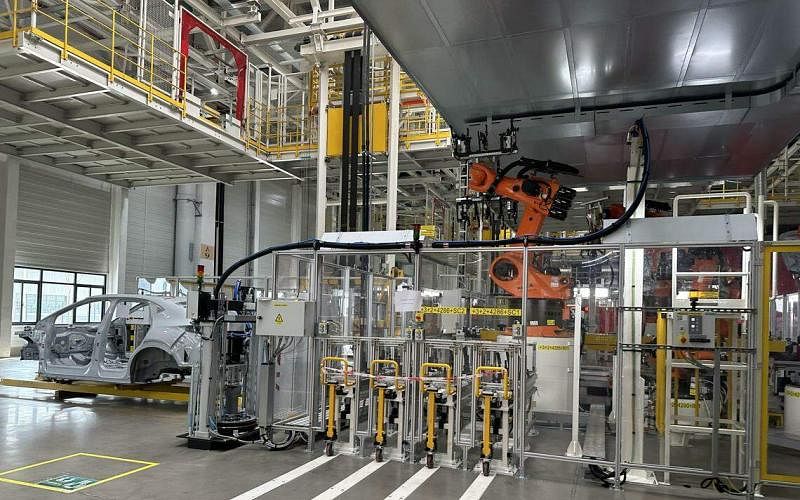In the center of the lobby of Hefei International Airport, what is on display are not urban elements and decorations, but NIO’s new energy vehicles.
Employees told the “Lianhe Zaobao” reporter that NIO (Nio for short) is a “local product” of Hefei By displaying the car in position C in the port hall -air can attract tourists to experience it statically and improve their understanding of NIO.
Hefei is the capital of Anhui Province in China, and NIO’s fate with this industrial city can be traced back to 2020. NIO was in dire straits due to a broken capital chain.
This life-saving money allowed Weilai to rise from the ashes. within two years,NIO achieved profit, the stock price has also been rising steadily, and the market value once exceeded 100 billion yuan. After that the Hefei government issued its NIO shares and received many returns.
From a long-term perspective, this investment has also attracted a large number of upstream and downstream companies, including Volkswagen, BYD, and lithium battery manufacturer Guoxuan Hi-Tech, creating the effect of industrial clustering and making Hefei an industrial agglomeration point for new energy. vehicles in China.
Hefei’s new energy vehicle output reached 740,000 units last year, ranking among the top five in the country; on average, one new energy vehicle rolls off the Hefei assembly line every minute.
In the center of the lobby of Hefei International Airport is the exhibition area of NIO’s new energy vehicles Passengers entering and exiting the airport can admire the 2024 NIO ET5T new energy vehicle nearby. (Photo by Lin Huizhi)
The outside world views Hefei’s investment in NIO as a successful gamble, bringing the “Hefei Model” to its best moment. The name “Hefei model” refers to the government attracting large projects in the form of investment to promote the development of industrial clusters and bring about the modernization and transformation of local industries.
In fact, Hefei, which is known as the “best enterprise capital” by the outside world, made two remarkable investments more than ten years ago. In 2017, he invested more than 10 billion yuan to establish a joint ventureChangxin Memory semiconductor companySpecializing in R&D and production of storage chips.
The conclusions of both investments are obvious. in China owns the entire integrated chain business.
Relying on the Hefei model, Hefei’s regional gross product (GDP) has grown at an average annual rate of more than 8% from 2012 to 2022, and will enter the “GDP Trillion City Club” in 2020. Hefei’s GDP also reached 1.27 trillion yuan last year, a year-on-year increase of 5.8%, which was 0.6 percentage points higher than the national level.
In this year’s government work report, Chinese Premier Li Qiang suggested that we should vigorously promote the construction of a modern industrial system.Accelerate the development of new productive forces. At a time when China’s real estate market is in deep trouble and the economy is undergoing transformation, the Hefei model has become a model for China to promote industrial innovation and technological development.
Less than two weeks after the end of the Two National Sessions, the Information Office of the State Council of China invited 25 domestic and foreign media to Hefei at the end of March to conduct interviews with them to learn how the local government and enterprises the development of new productive forces.
Reporters from 25 Chinese and foreign media visited the photovoltaic inverters displayed by Sungrow, a photovoltaic energy manufacturer in Hefei. (Photo by Lin Huizhi)
Some companies that are not often visited by foreign reporters, including the Sino-foreign joint venture of new energy vehicle manufacturer Volkswagen (Anhui), Hefei-headquartered Guoxuan Hi-Tech, visited Sungrow and other Chinese manufacturing export companies “three new companies”, on the media. . Open doors and bring in today’s products and technologies.
In the welding workshop of Volkswagen (Anhui) covering an area of 100,000 square meters, which is equivalent to 15 football fields, there are more than 1,000 multi-axis robots making new energy vehicles shortage workers.
Zink, director of the Volkswagen (Anhui) welding workshop, said that the automation level of the workshop is more than 90%, and there are only 140 workers in the entire workshop. “We can now produce 300 cars per day, but soon this number can increase to 1,200,” he said.
Volkswagen’s (Anhui) 100,000-square-meter welding workshop can produce 300 new energy vehicles per day. The huge factory has more than 1,000 multi-axis robots and only 140 employees. (Photo by Lin Huizhi)
The person in charge of almost every company interviewed emphasized the company’s investment in innovation and technology research and development, as well as Hefei’s advantages in business agglomeration and talent cultivation.
Luo Wenshan, deputy director of the Department of Industry and Information Technology of Anhui Province, pointed out in an interview that the success of local capital in promoting industrial transformation and modernization depends greatly on whether the government can properly grasp its make market-driven industrial development trends, and the Hefei government can do this First, it depends on a professional team that fully understands the way of industrial technology.
Talent is the main force in driving technological innovation. The school has trained nearly 60 academics from the Chinese Academy of Sciences and the Chinese Academy of Engineering. On average, there is one academic for every 1,000 undergraduate graduates, ranking first among Chinese universities.
Competition is fierce among China’s cities for high-tech talent
Nevertheless, interviews with government and enterprise officials indicated that Hefei still faces a talent shortage in high-tech industries amid fierce competition among cities for talent.
Zhang Yun, deputy director of the Anhui Provincial Development and Reform Commission, admitted in an interview that Hefei’s shortage of highly advanced talents in the field of new energy vehicles could reach more than 30,000 people in the next three years. “This is also a relatively big challenge,” he said.
Wang Qisui, senior vice president of Guoxuan Hi-Tech, also pointed out that in addition to high-level talents, blue-collar workers who match the new energy field are also in short supply. To solve this problem, the company must cooperate with some universities to “reserve” talents in this field in advance.
Wang Qisui, senior vice president of Guoxuan Hi-Tech, pointed out that Hefei’s employment structural contradictions are highlighted when the company hires in addition to top talents, there are blue-collar industrial workers who the new energy field was also a very poor match. (Photo by Lin Huizhi)
Unfavorable geopolitical factors have also increased uncertainty about Hefei’s transition to high-tech industries.
China’s “Three New Things” overcapacity has become a new point of disagreement between China and Europe and the United States in recent months.. The EU has so far launched countermeasures on new energy vehicles and wind turbines in China. As soon as the investigation determines that subsidies have been established, these products will be subject to higher taxes after entering Europe.
Zhang Yun admitted that the EU’s trade barriers have particularly affected Anhui’s exports, but he also said that the world market is very large, and Anhui’s exports to other regions are also doing very well. good, and can explore other markets at any time.
However, it is not easy for other cities in China to copy the “Hefei Model”.
Zhang Yun said that the Hefei model is based on the benefits of Anhui’s strategies, including the integration of the Yangtze River Delta, the Central Rise Plan, the One Belt and One Road and other national strategies. He said this provides Hefei with innovation advantages and an industrial base, as well as strong geographical functions and strategic location.
Another analysis pointed out that the success of the “Hefei Model” also includes the basic logic of the model, which effectively takes into account financial results and social development, strengthening the strength of local development through business transformation and modernization, and better meet local needs. human life. Before that, Hefei also suffered setbacks.
For example, Hefei, a city in the countryside, spent 4.6 billion yuan to incorporate Jiangsu Rongsheng Heavy Industry, China’s largest private shipping company, in 2007, and even spent a lot of money to to dig canals to solve the problem of exporting products. However, as the shipping market took a turn for the worse in 2012, Rongsheng Heavy Industry was hit with huge debts. The experience of this failure proves that the “challenging nature” approach is not feasible when cities seek industrial development.
Local officials in Anhui introduced the “Hefei experience” to visiting Chinese and foreign journalists on the right Luo Wenshan, deputy director of the Department of Industry and Information Technology of Anhui Province, Li Guoyang, deputy -director of the Anhui Provincial Department of Science and Technology, and Zhang Yun, deputy director of the Anhui Provincial Development and Reform Commission. Zheng Mingwu, deputy director of the Propaganda Department of the Anhui Provincial Party Committee, presided over the press conference. (Photo by Lin Huizhi)
Luo Wenshan said that the business base, talent supply and business judgment in each place must be comprehensively evaluated, whether the Hefei model can be replicated, and must be done according to local conditions.
“Adapting measures to local conditions” was emphasized by Hefei officials in interviews. This may be the knowledge they have gained from their years of investment experience.
Hefei’s experience proves that, in addition to the hard power of the local conditions, workers must also have the confidence and courage to try to learn from failed experiences, any investment decision has certain risks.
However, finances are currently tight in many parts of China, and risk tolerance is positively related to the financial strength of local governments. This also means that it will be more challenging to successfully replicate the Hefei model in other cities.
2024-04-21 11:02:00
#Featured #article #Hefei #model #creates #energy #industry #clusters #easy #copy

